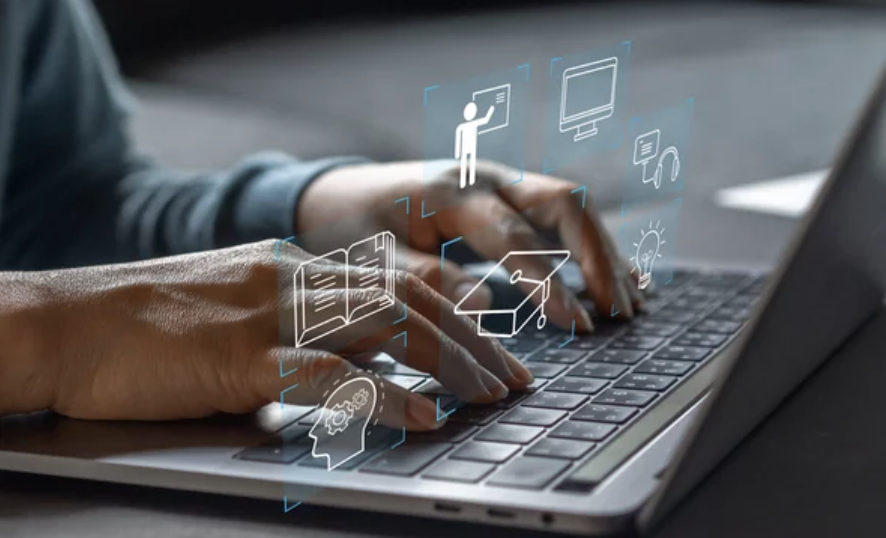Ever since we all abruptly pivoted to online instruction at the onset of the pandemic, conversations around e-learning have been front and center. Some of these conversations have been nuanced takes on the pedagogical adjustments necessary to maximize the utility of new learning delivery methods and the future implications of technologies as they evolve. Other conversations have been less productive, focusing on a “traditional v e-learning” binary framework. Very few of these discussions have stopped to clearly define their central term: what, exactly, is e-learning? Through clearly defining e-learning, educators can map a course towards improving learner outcomes in a way that speaks to their unique needs.
Defining e-learning
Broadly, e-learning can be thought of as part of a new dynamic that characterizes educational systems in the early 21st century resulting from the merge of different disciplines, such as computer science, communication technology, and pedagogy (Sangrà et al., 2012). E-learning has been somewhat inconsistently defined across academic literature and the popular press being used synonymously with everything from online learning, remote learning, virtual learning, computer-assisted learning, web-based learning, hybrid learning, blended learning, and many, many more terms. All of these terms allude to the notion that we’ve moved beyond the traditional learning delivery models that dominated education in the 20th century; all of the phenomena these terms describe are part of the e-learning ecosystem. Yet none of these terms sufficiently define e-learning and, when used interchangeably, sometimes muddy the waters of discussions around e-learning.
Sangrà, Vlachopoulos, and Cabrera (2012) conducted an extensive literature review and surveyed experts in the e-learning field before defining e-learning as “an approach to teaching and learning, representing all or part of the educational model applied, that is based on the use of electronic media and devices as tools for improving access to training, communication, and interaction and that facilitates the adoption of new ways of understanding and developing learning.”
It’s useful to tease out the above definition by highlighting two key elements of e-learning:
- Electronic media and devices are the means of educational delivery that mediate the learners and instructor at least part of the time (Angelino, Williams, & Natvig, 2007; Rovai, 2002).
- As technology and exploration of new educational models continue to evolve, so will e-learning.
Electronic Media and Devices are Ubiquitous in Modern Education
The use of electronic media and devices as a mode of mediating educational delivery is a hallmark of e-learning. This could look like an all-remote Zoom lecture with break out rooms, but it could also look like a 5 day a week in-person class with a discussion forum and feedback on assignments delivered through a learning management system. The vast majority of modern learning incorporates some technological component to its instructional design.
E-learning Evolves with Technologies, Learner Needs, and Educational Models
As dramatically evidenced by the onset of the pandemic, learning needs change very quickly and the concept and functions of e-learning must continuously be adapted to these needs (Sangrà et al, 2012). Add in the quickly changing nature of the uses of the technology for teaching and learning as well as the changing natures of the technologies themselves and it becomes plain that we’re dealing with an almost continuously evolving phenomenon. E-learning is a wide-ranging, new, and evolving learning model that educators and institutions can tailor to the needs of their unique student populations.
Good pedagogy and instructional design make use of all the educational tools in the instructor’s toolbox based on learner needs; they don’t take a one size fits all approach and simply map a traditional 20th-century classroom approach onto a virtual landscape. An approach along the lines of “just like an in-person class only on Zoom” is bound to fail not because it’s e-learning, but because it doesn’t adapt itself to the new means of educational delivery. Bad pedagogy is bad pedagogy. Thoughtful, strategic utilization of the many tools and educational delivery methods e-learning makes available to nearly all classrooms can open doors for all learners.
The research backs up what we already know: e-learning isn’t just the future; it’s the present and it’s here to stay (Schwartz et al, 2020; Bashir, A., et al. 2021). It is much more productive to be clear-eyed about where we are and work to maximize e-learning’s vast potential rather than engaging in a fruitless debate about e-learning vs traditional learning.
The question is not whether e-learning is “good” or “bad;” it’s how can we as educators evolve with it?
Want to get the most out of e-learning at your institution? Schedule a meeting with us or take advantage of our webinars. We’d love to help you harness the power of your data.
REFERENCES:
Angelino, L.M., et al. “Strategies to engage online students and reduce attrition rates.” The Journal of Educators Online, vol. 4, no. 2, 2007, pp. 1-14. Semantic Scholar, . https://doi.org/10.9743/JEO.2007.2.1.
Bashir, A., et al. “Post-COVID-19 Adaptations; the Shifts Towards Online Learning, Hybrid Course Delivery and the Implications for Biosciences Courses in the Higher Education Setting.” Frontiers in Education, vol. 6, 2021, https://doi.org/10.3389/feduc.2021.711619.
Rovai, A. “Building sense of community at a distance.” International Review of Research in Open and Distance Learning, vol. 3, no. 1, 2002, pp. 1-16, https://doi.org/10.19173/irrodl.v3i1.79.
Sangrà, A., et al. “Building an Inclusive Definition of E-Learning: An Approach to the Conceptual Framework.” The International Review of Research in Open and Distributed Learning, vol. 13, no. 2, 2012, pp. 145-159, https://doi.org/10.19173/irrodl.v13i2.1161.
Schwartz, H., et al. “Remote Learning Is Here to Stay Results from the First American School District Panel Survey.” 2020. RAND Corporation, https://doi.org/10.7249/RRA956-1.

Elizabeth Dalton measures and improves educational tools, processes, and results by using her experience in instruction and assessment design, development, documentation, and delivery, combined with her knowledge and expertise in technology and statistical methods.
Resources
Explore Learning Analytics Insights
How to Set Up Your LMS to Support Executive Function
When educators view their courses through a learner-centered Executive Function lens, they can support learners’ executive skills.
LAK 24: Report from Kyoto
LAK 24: Report from Kyoto
Elevating Data Accessibility with IntelliBoard’s New Design
Read how learning analytics can increase student engagement




